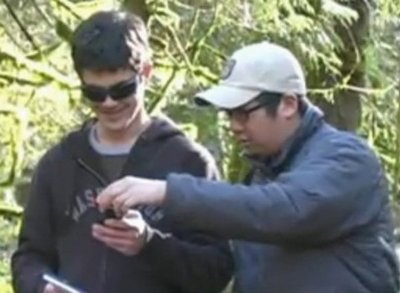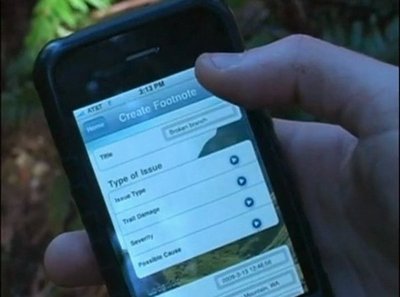June 25, 2009
Capstone projects offer solutions to real-world problems
Problem: Hikers sometimes see trail damage such as downed trees, rock slides or vandalism before trail maintenance crews but can’t always remember or document precisely where they saw the damage.
Solution: Footnotes — a software application that documents trail problems via smart phones and a Web site.
The inventors of Footnotes, along with other students graduating from the UW Information School, presented their work at a capstone event on Thursday, June 4, in the HUB.
Master’s degree students and senior undergraduates use capstone projects to bring years of learning together, often to solve real-world problems.
This year’s 55 projects included improving the help desk at the Veterans Administration Puget Sound Hospital, upgrading product forecasting for Mike’s Hard Lemonade and helping with civic work via software applications that run on smart phones.
Ben Fields, Dong Jin Ahn and Kevin Merritt dreamed up Footnotes as the result of hiking. “We’ve found that trail maintenance often lags behind trail use,” Merritt said.
Their software application lets hikers select trail problems from a drop-down menu, tag the problems with geographic coordinates, then send the notes to volunteer organizations or government groups, either immediately or later on.
Ahn, Fields and Merritt tested Footnotes with hikers on Tiger Mountain southeast of Seattle and are using the information to update their Footnotes Web site: http://www.trailfootnotes.com/.
They have also created a YouTube video about Footnotes: (http://www.youtube.com/watch?v=u6DmHr8kKlA) and are talking with at least one venture capitalist about commercial uses of their software.
Meanwhile, Sonja Rogneby and Monica Wynn’s new device has helped a local grassroots organization. They invented the City Fruit Tree mapping tool, a software program that like Footnotes runs on mobile devices such as smart phones. The tool is also available at a Web site: http://city-fruit.appspot.com.
“Parts of Seattle have been built on old orchards, and it’s been interesting to see how these old orchards behave now,” said Rogneby, a business systems analyst at TMobile, who graduated this month with a master’s degree in information management.
In nooks and crannies of Maple Leaf neighborhood of Seattle where Rogneby lives, she has seen fruit growing both wild and cultivated. How terrific it would be, thought both she and Wynn, if people could know where this food is growing, particularly if it could be harvested for people who need it.
Mike Crandall, a senior lecturer who chairs the Executive Master of Science in Information Management Program, connected Wynn and Rogneby with City Fruit, the grassroots outfit that wants to map Seattle’s fruit trees.
Wynn and Rogneby’s work allows City Fruit volunteers to catalog neighborhood trees so as to improve harvesting, donation, research and policy making. Users of the tool can add their trees to the map, indicate whether fruit is available for harvest and donation, and seek information about pruning.
Users also can find local fruit as well as download data into an Excel spreadsheet for further analysis.
Wynn, an operations manager for PayNorthwest, a firm which handles payroll and human resources for small companies, said focusing on simplicity was crucial. The tool captures just enough about trees to make the information useful for several groups of people, including volunteers, scientists and policy makers, Wynn said.




